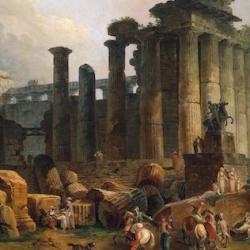At the 2014 Biblical Horizons summer conference last week, James Jordan argued that, unlike the tabernacle that is a reconstituted garden, the temple draws its imagery from the land.
The architectural symbolism of the temple includes trees, pomegranates, lilies, lions, palm trees, and other flora and fauna that were not included in the tabernacle. As is clear from the combination of imagery in the Song of Songs, the land and temple mirror each other.
To this we can add the fact that Solomon, unlike Moses, builds himself a house right next to the temple.
To understand these differences between tabernacle and temple, we have to recall the geography of the original creation. Adam was created and placed in a garden in Eden. The garden was not the highest point in Eden, and the trees of the garden carried an implicit promise that Adam would one day ascend from the garden to the mountaintop.
Adam failed to do that, but the Adamic people Israel did make the climb, in the person of their king: Israel reenters the garden with the building of the tabernacle, but by the time the king comes Israel has been given access to the land, a land at peace that flows with milk and honey. Beyond the tabernacle, the temple fulfills the promise of Adam, as Israel is ruled by a king with heavenly wisdom who knows good and evil.














